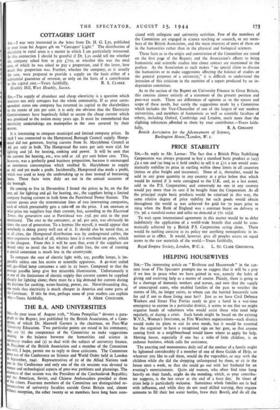Sta,—The supply of abundant and cheap electricity is a question
which interests not only cottagers but the whole community. If as your corre- spondent states one company has returned its capital to the shareholders to the extent of 220 per cent, it is only too obvious that the Electricity Commissioners have hopelessly failed to secure the cheap current which was promised to the nation many years ago. It must be remembered that electricity undertakings are monopolies in the area covered by their statute.
It is interesting to compare municipal and limited company prices. In 1938 I was connected to the Hampstead_ Borough Council supply. Hamp- stead did not generate' buying current from St. Marylebone Council at .6d. per unit in bulk. The Hampstead flat rates per unit were 20. for lighting and d. for heating, cooking and power. It will be seen that
the current for heating, etc., was sold at per unit below cost. This, however, was a perfectly good business proposition, because it encouraged an enormous consumption which enabled St. Marylebone to supply at .6d. and yet made a profit. Incidentally, Hampstead also made a profit, which was used to keep the undertaking up to date instead of borrowing loans. These facts were duly set out in the annual accounts of the borough.
On coming to live in Devonshire I found the prices to be, on the flat rate, 9d. for lighting and 4d. for heating, etc., the suppliers being a limited company buying current in bulk from the Portishead Power Station. The current passes over the transmission lines of two intervening companies, each of which presumably gets a rake-off on the price. I am unaware at what price my suppliers buy their current, but, according to the Electrical Times, the generation cost at Portishead was .15d. per unit in the year mentioned. The cost to the consumer, at 9d. per unit, was obviously 60 times the cost of generation. To a layman like myself, it would appear that somebody is doing pretty well out of it. It should also be noted that, as in all cities, the Hampstead distribution was by underground cables, the most expensive method of all, whereas here it is overhead on poles, which is the cheapest. From this it will be seen that, even if the suppliers are bound only to instal the last 60 feet of cable free, the cost of running a special connexion is much less in the countryside.
To compare the cost of electric light with, say, paraffin lamps, is im- possib:e unless one has, access to scientific apparatus. A 40-watt coiled coil, gas-filled lamp consumes a unit in 25 hours. Compared to that the average paraffin lamp give but miserable illumination. Unfortunately it is one of the limitations of electric supply that current cannot be supplied theaply for lighting alone; there must be a big demand for current during the daytime for cooking, water-heating, power, etc. Notwithstanding this, site reads that electricity is much cheaper in America and some parts d the Continent. If this be true, perhaps some of your readers can explain


























 Previous page
Previous page